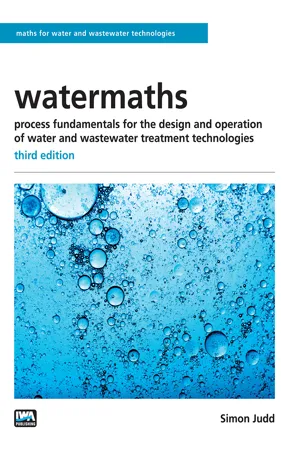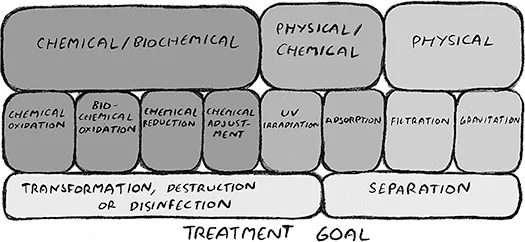
- 142 pages
- English
- ePUB (mobile friendly)
- Available on iOS & Android
eBook - ePub
About this book
Watermaths presents the mathematics underpinning the design and operation of the individual unit process technologies used for purifying water and wastewater. The book aims to provide the reader with sufficient information to enable them to tackle the most important calculations in this area, without requiring any prior knowledge of the subject and assuming only a very basic grounding in science or engineering. It focuses on the most essential areas of knowledge required, containing tuition in basic numeracy, chemistry, process engineering and fluid physics, as well as cost analysis. The simple and succinct delivery is designed to get the reader up to speed as rapidly as possible: sufficient background information is provided to explain the purpose of the calculations, and ultimately tackle the complete wastewater reclamation plant design problem included in the book.
Example calculations are provided within each chapter, each followed by exercises intended to reinforce the learning (and for which solutions are appended). Exercises range in difficulty from simple single calculational-step problems to more complex ones, and the over-arching design problem provides some context to the mathematics. The book can be understood by those relatively new to the water sector, and is intended as a primer rather than a comprehensive handbook. It is nonetheless sufficiently comprehensive to permit design calculations for most water and wastewater treatment unit processes.
Core disciplines covered include:
• manipulation of equations, including logarithmic and exponential expressions
• fluid physics for describing flow through pipes, channels and filters
• chemical concentrations and chemical/biochemical reactions
• chemical/biochemical reaction kinetics
• mass balance for determining fate of materials through unit processes
• mass transfer for determining transfer of materials across boundaries within processes
• reactor theory for designing biochemical and chemical reaction vessels
• cost analysis, including capital and operating expenditure with discounting.
New to the third edition:
• new chapter on cost analysis
• further explanation of the classical unit operations types
• illustrations expanded to include unit operation schematics and symbols
• new examples and exercises
• updated design problem.
Watermaths … just add water.
Frequently asked questions
Yes, you can cancel anytime from the Subscription tab in your account settings on the Perlego website. Your subscription will stay active until the end of your current billing period. Learn how to cancel your subscription.
At the moment all of our mobile-responsive ePub books are available to download via the app. Most of our PDFs are also available to download and we're working on making the final remaining ones downloadable now. Learn more here.
Perlego offers two plans: Essential and Complete
- Essential is ideal for learners and professionals who enjoy exploring a wide range of subjects. Access the Essential Library with 800,000+ trusted titles and best-sellers across business, personal growth, and the humanities. Includes unlimited reading time and Standard Read Aloud voice.
- Complete: Perfect for advanced learners and researchers needing full, unrestricted access. Unlock 1.4M+ books across hundreds of subjects, including academic and specialized titles. The Complete Plan also includes advanced features like Premium Read Aloud and Research Assistant.
We are an online textbook subscription service, where you can get access to an entire online library for less than the price of a single book per month. With over 1 million books across 1000+ topics, we’ve got you covered! Learn more here.
Look out for the read-aloud symbol on your next book to see if you can listen to it. The read-aloud tool reads text aloud for you, highlighting the text as it is being read. You can pause it, speed it up and slow it down. Learn more here.
Yes! You can use the Perlego app on both iOS or Android devices to read anytime, anywhere — even offline. Perfect for commutes or when you’re on the go.
Please note we cannot support devices running on iOS 13 and Android 7 or earlier. Learn more about using the app.
Please note we cannot support devices running on iOS 13 and Android 7 or earlier. Learn more about using the app.
Yes, you can access Watermaths by Simon Judd in PDF and/or ePUB format, as well as other popular books in Biological Sciences & Applied Sciences. We have over one million books available in our catalogue for you to explore.
Information
© IWA Publishing 2019. Simon Judd Watermaths: Process Fundamentals for the Design and Operation of Water and Wastewater Treatment Technologies DOI: 10.2166/9781789060393_0001
Chapter 1
Introduction
1.1 WATER AND WASTEWATER TREATMENT PROCESSES
The treatment of water or wastewater relies on a number of individual unit operations which are combined to make a process, often referred to as a process treatment scheme. Although seemingly complicated and diverse in practice, these unit operations are all work according to a relatively narrow range of governing principles – whether water from the ground, lakes, reservoirs, rivers or the sea is to be purified for drinking, or wastewater (i.e. sewage or industrial effluent) is to be cleansed for safe discharge to the environment. These principles, or disciplines, can be summarised as physical separation (primarily sedimentation and filtration), fluid physics (hydraulics, rheology), chemistry or biochemistry (stoichiometry, kinetics, equilibrium thermodynamics), and chemical engineering (reactors, mass balance, mass transfer). Whilst this list may not be comprehensive, most common water and wastewater treatment processes are based on these core areas of science and engineering. It is also the case that the design of the unit operations based on such principles demands only a cursory knowledge of mathematics – in essence, just arithmetic (i.e. calculations) and the manipulation of equations.
Fluid physics (Chapter 3) and mass balance (Chapter 6) define the transport of liquid and solids in and between unit operations. The basis of the unit operations, and specifically the way in which contaminants are removed from the water, is defined almost entirely by physical separation and chemistry/biochemistry (Figure 1.1). Thus, suspended solids in water are removed either by settling (sedimentation or gravitation, Section 7.5) or filtration, often through a bed of sand (i.e. depth filtration, Section 3.7). Dissolved materials may also be removed by adsorption (Section 4.6.8), and in this case the action of the adsorbent (i.e. the medium adsorbing the pollutant) is based on physical chemistry.

Figure 1.1Unit operation principles in water and wastewater treatment.
Pollutants may also be transformed into either less onerous products or ones which can be removed physically by a subsequent unit operation. The transformation of a dissolved chemical into another (sometimes mis-named “destruction”) is a key part of chemistry, and the chemical action of an organism affecting such a transformation is the basis of biochemistry. In general, these processes tend to oxidise (i.e. add oxygen to) the pollutant, and biochemical reactions in particular can completely oxidise organic (i.e. large carbon-based molecular) pollutants to the most simple mineral (inorganic) end products. Many chemical oxidants, such as chlorine and ozone, have the power to inactivate (i.e. kill) bacteria and viruses and are thus defined as disinfectants. Disinfection may also be achieved by UV irradiation. Finally, some chemical reactions do not involve oxidation or reduction, but simply adjust the chemical conditions of the water, such as its acidity or the solubility of the pollutants.
Chemical and biochemical reactions are represented by equations, analogous to mathematical equations, which define the ratio of a chemical reagent used to treat the water with the chemical pollutant it is transforming. This is referred to as stoichiometry (Section 4.5). Other aspects of chemistry are the rate at which reactions proceed, referred to as kinetics (Chapter 5), and the balance of reactants and products at the end of the reaction, referred to as equilibrium thermodynamics (Section 4.6).
Whilst all of these subjects, if explored comprehensively, are very broad and encompass a wide variety of topics, when applied to water and wastewater treatment process technology design and operation the scope is quite limited (Table 1.1). The following chapters provide sufficient information to enable the basic design of water and wastewater treatment processes based on the most common unit operations. By way of demonstrating this, the design and operational elements of a complete installation for advanced wastewater treatment for water recovery and reuse will be considered as an example in a subsequent section (Section 1.4).
Table 1.1 Classical unit operations and their main governing disciplines/subjects.
Unit Operation | Fluid Physics | Physical Separation1 | (Bio) Chemistry2 | Chemical Engineering3 |
Pumping | X | |||
Screening | X | SF | ||
Sedimentation/flotation | X | Gr | MB | |
Scrubbing/stripping | X | St | MB, MT | |
Biological treatment | St, K | MB, MT, R | ||
Coagulation/flocculation | St, ET, K | R, MB | ||
Acidity adjustme... |
Table of contents
- Cover
- Half Title
- Title Page
- Copyright Page
- Contents
- List of Tables
- List of Figures
- List of Abbreviations
- Units, SI
- Symbols
- Preface
- Chapter 1: Introduction
- Chapter 2: Mathematics
- Chapter 3: Fluid physics
- Chapter 4: Chemical stoichiometry and equilibria
- Chapter 5: Chemical and biochemical kinetics
- Chapter 6: Mass balance
- Chapter 7: Mass transfer and sedimentation
- Chapter 8: Reactor theory
- Chapter 9: Cost analysis
- Chapter 10: Solutions to exercises